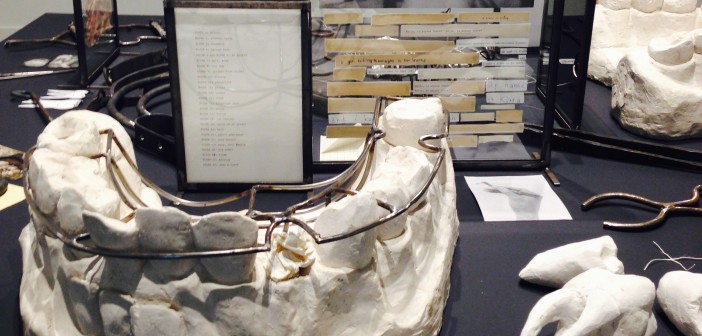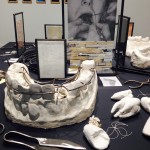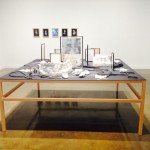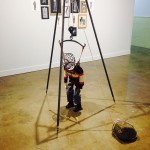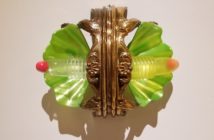Standing at the forefront of investigation and reflection into the complex social and cultural issues underlying a changing world, the List Visual Arts Center at MIT provides a perfect context for the Prague-based artist Eva Koťátková’s first solo museum exhibition in the United States.
“Be careful of that trap,” a gallery attendant alerts me. In most cases we would all agree that when a gallery attendant says something to a visitor, aside from a pleasant hello or how are you, the remark is to safeguard the artwork on exhibit. The growth of performance-based, installation, and immersive art increasingly challenges the notion of a static artwork that can only be viewed at a safe distance. Nonetheless, conservators, gallerists, or museum curators do have a duty of preserving an experience for future visitors. After spending an extended period of time at Eva Koťátková’s show Out of Sight, I am putting such focus on one gallery attendant’s remark because, although subtle, it reinforces the irony behind giving form to the invisible.
So what is the invisible matter Koťátková is tackling? This exhibition combines many of the artist’s earlier works of archival displays, sculptural assemblage, and welding, with new projects that bring together cage-like objects, collage, and installation. Archaic medical equipment, outmoded restraints for mental patients, or medieval torture devices are some of the resources she pulls from. She then combines text, audio, and found photographs and objects to curate a collection incorporating her own sculptural elements. Sculptures of entrapment or motifs of a fragmented/incomplete body are a reoccurring depiction, but the artist is not one to point to actual physical violence.
Of the three human-scale metal sculptures on display on the gallery floor, one of them was the one I almost tripped on. First and foremost, I am not critiquing the safety at play within museums. If it were not for the attendant’s remark I may have tripped (let’s pretend that if I did trip, it would have been worse than a stubbed toe). These particular cage-like sculptures are actually based off animal traps, and are fully functional as such. As humans, we are technically animals as well, so what does the cautionary instinct to alert a person of an animal trap (i.e. artwork in this particular case) say about the blurred line between animals and humans? Perhaps the artist’s interest in psychiatry, medical textbooks, and social constructions speaks to this relationship.
The study of mental illnesses and the use of psychoanalysis to understand why a person fails to fall in line with society’s expectations is a measure that has grown and unraveled through the 20th to 21st century. Yet if we look to Surrealism’s influence, as Koťátková does, then we will see that the distinction between normalcy and absurdity remains thin.
A trap, such as a cage, is crueler than a wall, Koťátková stated during an interview for her installation Asylum at the 2013 Venice Biennale [1]. When inside a “cage” you are imprisoned, she notes, but you are still able to perceive your surrounding environment, and there develops a dynamic shift between you and the person on the opposite side of the metal barrier. We can think back to the iconic performance of Guillermo Gómez -Peña and Coco Fusco in Couple in the Cage for a more expanded idea of how the cage metaphor operates.
Absurd, phantasmagoric, distorted—these are words in line with the art movements that paved the way for illogical visual imagery (Dadaism for example), wherein a reader or viewer was the one to make judgments of characters, scenes, and environments not in line with societal norms. Koťátková is well versed in the language imbued within her objects; passivity is not in her repertoire, and she is well aware of the emotions her work elicits. This is to say that a synopsis of the exhibit or works on view is not necessary, because research-based exhibitions (the artist had ongoing visits to the Bohnice Psychiatric Hospital outside of Prague) such as these open a window of opportunity for a viewer to expand their understanding on an array of esoteric material. Take for example the Corridor of Ideas, a hallway connecting two of the gallery spaces, where smudges and marks on the wall, along with a leather bag, blank sketchbook, and children voices, make a compelling recreation of a realistic narrative. However, if one spends time listening to the faint audio coming from the single hole in the wall, the artificiality of the narrative becomes rather clear. You may even make out a child saying, “you can’t see things the way they are”. This imaginary recollection of events, labeled as Ideas, echoes the tension at play throughout the exhibition, between realistic structures, anxieties, relations and the invisible prisons that support and uphold an individual’s internal struggles.
The objects of entrapment, whether sculptural, drawn, or linguistic, that Koťátková employs as her visual vocabulary are not forms for physical imprisonment, but rather they provide a literal metaphor for the mental cages we construct. Our constructions are based on the relationships we hold with society, conventions, rules, institutions, and family, and the resulting fears, anxieties, or phobias that become the barbwire for our mental confinement. This is perhaps the most condensed way of viewing work by an artist whose upbringing arguably gets her grouped with other artists of communist Cold War nations. It is both uncertain and unavoidable, the postulation of a direct influence between artwork that takes as its central theme relationships to normative social structures, and the effects of life under a totalitarian regime. But considering that her upbringing is subtly noted in the exhibition description, in a show with a great deal of images of children and adolescence, it becomes a matter of significance and perhaps a trap-of-logic as well.
Out of sight, as the title of the exhibit implies, references the forms the artist gives to the invisible. When we think of entrapment it is given a negative connotation. As much as this exhibition points to the invisible barriers we either construct ourselves or others construct for us, my time spent in the gallery provided evidence to the intuitive reactions we posses toward physical forms. Would a gallery attendant ever caution, “Be careful of making sense out of art–it’s a trap”?
At one point in history, if a person—be it child or adult—was not making “sense”, speaking gibberish perhaps, their lack of being understood would be seen as insanity and treated with outmoded restraints—devices Koťátková collects, archives, and manipulates. Now less pervasive approaches exist, but we can’t deny that being understood is a rather fundamental desire in life with significant consequences. Society relies on a clear distinction between logic and absurdity– is something darkly humorous, poetic, or thoughtfully critical? Undoubtedly this exhibition is an agglomeration of all such points, and the fact that Koťátková also regards slapstick comedy as influential is no surprise. If I were to fall prey to a trap on exhibit (pun fully intended), I could have gotten hurt; I could have caused logistic issues for the museum staff; my fall could have gone fully unnoticed; or in a Charlie Chaplin like way, a trip-on-a-trap may have produced a few laughs. Quite the range a single trap can produce. Yet it’s the physical traps that are the easiest to avoid, one just needs the proper forewarning.
[1]Biennale Arte 2013 - Eva Kotatkova. Perf. Eva Kotatkova. Biennale Arte 2013 - Eva Kotatkova. La Biennale Di Venezia Channel, 19 May 2013. Web. <https://www.youtube.com/
-------
“Eva Koťátková: Out of Sight” is on view at MIT List Visual Arts Center until July 26th, 2015. Further information here.

